Kaplan MCAT Biochemistry Chapter 7: RNA and Genetic Code – Flashcards
Unlock all answers in this set
Unlock answersquestion
Gene

answer
A unit of DNA that encodes for a specific protein or RNA molecular, which can be expressed via transcription and translation
question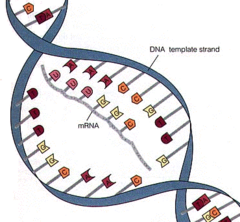
Messenger RNA (mRNA)

answer
Carries the message from DNA in the nucleus via transcription of the gene; it travels into the cytoplasm to be translated.
question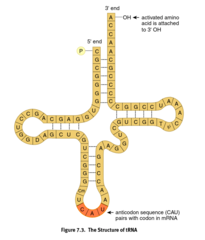
Transfer RNA (rRNA)

answer
Bring the amino acids and recognizes the codon on the mRNA using its anticodon. When bound to AA, it is charged, and is a high energy bond
question
Ribosomal RNA (rRNA)
answer
Synthesized in the nucleolus and functions as an integral part of the ribosomal machinery used during protein assembly in the cytoplasm. Makes up the ribosome and its enzymatically active.
question
Codon
answer
A three-nucleotide sequence of DNA or mRNA that specifies a particular amino acid or termination signal; the basic unit of the genetic code.
question
Start codon
answer
AUG *think starts school in AUGest*
question
Stop codons
answer
1) UGA - U Go Away 2) UAG - U Are Gone 3) UAA - U Are Annoying
question
Point mutations
answer
Specific mutations one piece of a codon: 1) Silent 2) Nonsense 3) Missense
question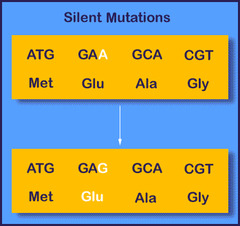
Silent mutations

answer
Causes no effect in the protein sequence due to redundancy in the wobble position (third base in codon)
question
Nonsense (truncation)
answer
Mutation that produces a premature stop codon.
question
Missense mutation
answer
Mutation that produces a codon that codes for a different amino acid.
question
Frameshift mutation
answer
Mutation that results from nucleotide addition or deletion, and change the reading frame of subsequent codons.
question
RNA vs DNA
answer
RNA has: 1) A ribose sugar instead of deoxyribose 2) Substitution of uracil for thymine 3) Single-stranded instead of double-stranded
question
Monocistronic
answer
The coding pattern of eukaryotes in which one mRNA molecule codes for only one protein.
question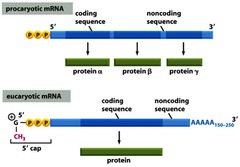
Polycistronic

answer
The coding pattern of prokaryotes, in which one mRNA may code for multiple proteins.
question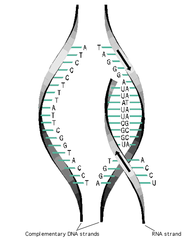
Transcription

answer
The creation of mRNA from a DNA template.
question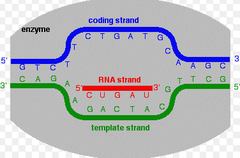
DNA strands to be transcribed

answer
1) Coding strand 2) Template strand
question
RNA polymerase

answer
Enzyme that links together the growing chain of RNA nucleotides during transcription using a DNA strand as a template 1) Reads 3' to 5' but adds 5' to 3' 2) Does no proof reading 3) Continues until it reaches a termination signal.
question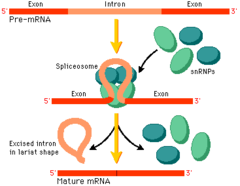
hnRNA

answer
Heterogeneous RNA. RNA that has been freshly transcribed and has not underwent any post transcriptional modifications.
question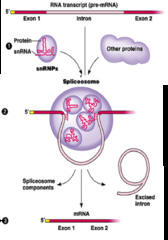
Splicesome

answer
a complex of specialized RNA and protein subunits that removes introns from a transcribed pre-mRNA segment. Contain: 1) snRNA 2) snRNPs or "snurps"
question
5' Cap
answer
A 7-methylguanylate triphosphate cap that protects mRNA from degradation in cytoplasm and is a recognized binding site for ribosomes.
question
3' Poly-A tail

answer
A poly-A tail is composed of adenine and is added to the 3' end of the mRNA transcript and protects the message against rapid degradation. Longer the poly-A tail = longer time before degradation.
question
Introns
answer
Noncoding segments of nucleic acid that lie between coding sequences.
question
Mechanism of transcription
answer
1) Helicase and topoisomerase unwind the dsDNA. 2) RNA polymerase II binds to TATA box within the promoter region of the gene (25 base pairs upstream) 3) hnRNA is synthesized from the DNA template (antisense) strand and stopped once termination signal. *Post-translational modifications* 4) A 7-methylguanylate triphosphate cap added to 5' end. 5) Poly-A tail added to 3' end 6) Splicing done by snRNA and snRNPs in the spliceosome. Process removes introns. 7) Alternative splicing (combining of exons) allows more variability of gene products 8) Leave nucleus and into cytosol.
question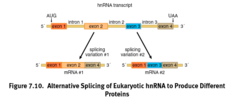
Alternative splicing

answer
Splicing of introns in a pre-mRNA that occurs in different ways, leading to different mRNAs that code for different proteins or protein isoforms. Increases the diversity of proteins.
question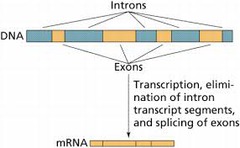
Exons

answer
A coding region of a eukaryotic gene. Exons, which are expressed, are separated from each other by introns.
question
Ribosome
answer
Factories for the translation of mRNA into proteins. Composed of proteins and rRNA with variability among prokaryotes and eukaryotes.
question
Ribosomal sub-weight (Two domains)
answer
Eukaryotic Ribosome = 80 S Prokaryotic Ribosome = 70 S Where S value is determined experimentally by studying the behavior of particles in a centrifuge.
question
Mechanisms of Translation
answer
1) Initiation begins for eukaryotes when 40S ribosome attaches to 5' cap and begins scanning for a start codon. 2) Once AUG is found, it lays down a methionine in the P site of the ribosome. 3) Elongation begins and new tRNA come into site A of the ribosome and transfer growing polypeptide chain from tRNA in the P site to tRNA in the A site. 4) The now uncharged tRNA exits the ribosome via the E site. 5) Process continues until stop codon is reached and a release factor places a water molecule on the polypeptide chain causing release of protein. *Post-translational modifications* 6) Folding by chaperones, formation of quaternary structure, cleavage of protein or signal sequences, or the covalent addition of other biomolecules.
question
Phosphorylation
answer
The addition of phosphate group by protein kinases to activate deactivated proteins.
question
Carboxylation
answer
Addition of a carboxylic acid group, usually serves as calcium binding sites.
question
Glycosylation
answer
Addition of oligosaccharides as proteins pass through the ER and Golgi apparatus to determine cellular destination.
question
Prenylation
answer
Addition of lipid groups to certain membrane-bound enzymes.
question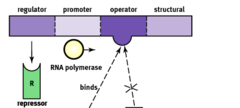
Operon Structure

answer
Essentially an "on-off" switch that regulates gene expression. Composed of: 1) Regulator 2) Promoter 3) Operator 4) Structural
question
Regulator gene
answer
Codes for the protein known as a repressor that prevents gene transcription.
question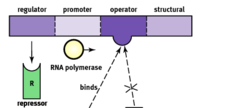
Promoter site

answer
Site where RNA polymerase will bind to begin transcription. About ~25 base pairs upstream
question
Operator

answer
A non transcribable region of the DNA that is capable of binding a repressor protein and preventing transcription.
question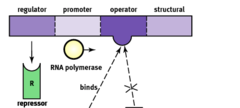
Structural gene

answer
Codes for the protein of interest
question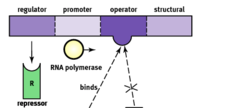
Inducible system

answer
Systems that are bonded to a repressor under normal conditions. 1) They can be turned on by an inducer pulling the repressor from the operator site. Ex) lac operon.
question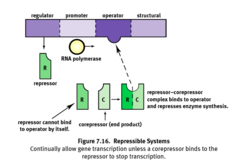
Repressible system

answer
System that is transcribed under normal conditions. 1) Can be turned off by a corepressor coupling with the repressor and binding to the operator. Ex) Trp operon
question
Transcription factors
answer
Collection of proteins that mediate the binding of RNA polymerase and the initiation of transcription.
question
Enhancers
answer
Are more than 25 base pairs away from the transcription start site.
question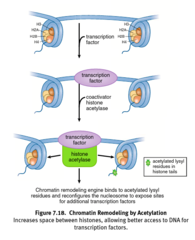
Histone Acetylation

answer
Acetylation of histones decreases positive charge on lysine residues and weakens histone-DNA interactions. Results in open euchromatin formation that allows for easier asses for transcription factors. Acetylation = Access
question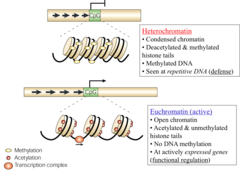
DNA methylation

answer
Add methyl groups to cytosine and adenine nucleotides. Methylation of genes is often linked with silencing gene expression. The heavily methylated DNA hinders transcriptional machinery.
question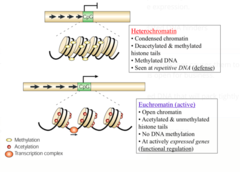
How to make DNA open/ closed for transcription?

answer
Closed = methylated DNA that will pack tightly into heterochromatin. Open = acetylation of histones causes them to form euchromatin that is open for business.
question
If a DNA sequence is 5' - TCTTTG - 3', what is the transcribed RNA strand?
answer
5' - CAAAGA - 3' because mRNA is antiparallel to DNA



